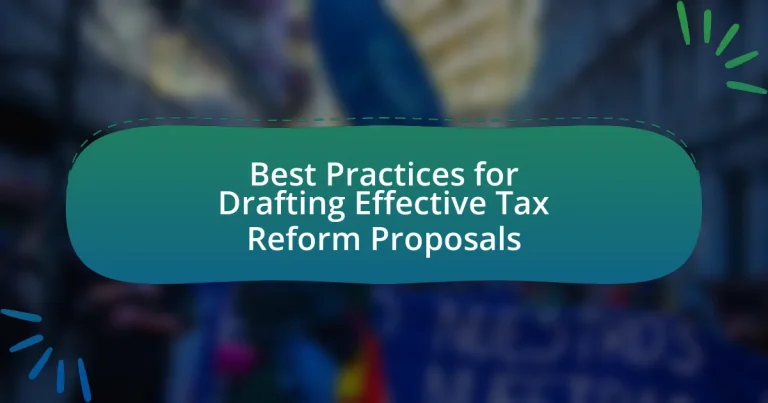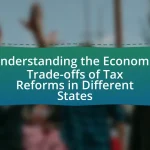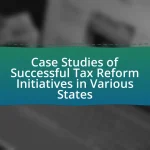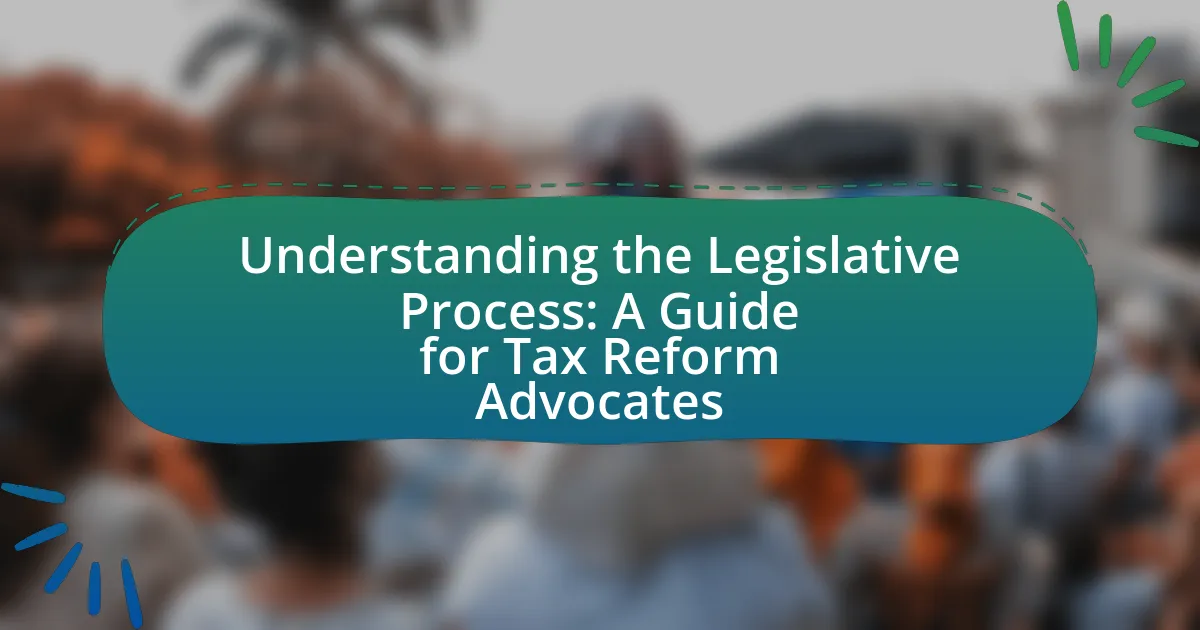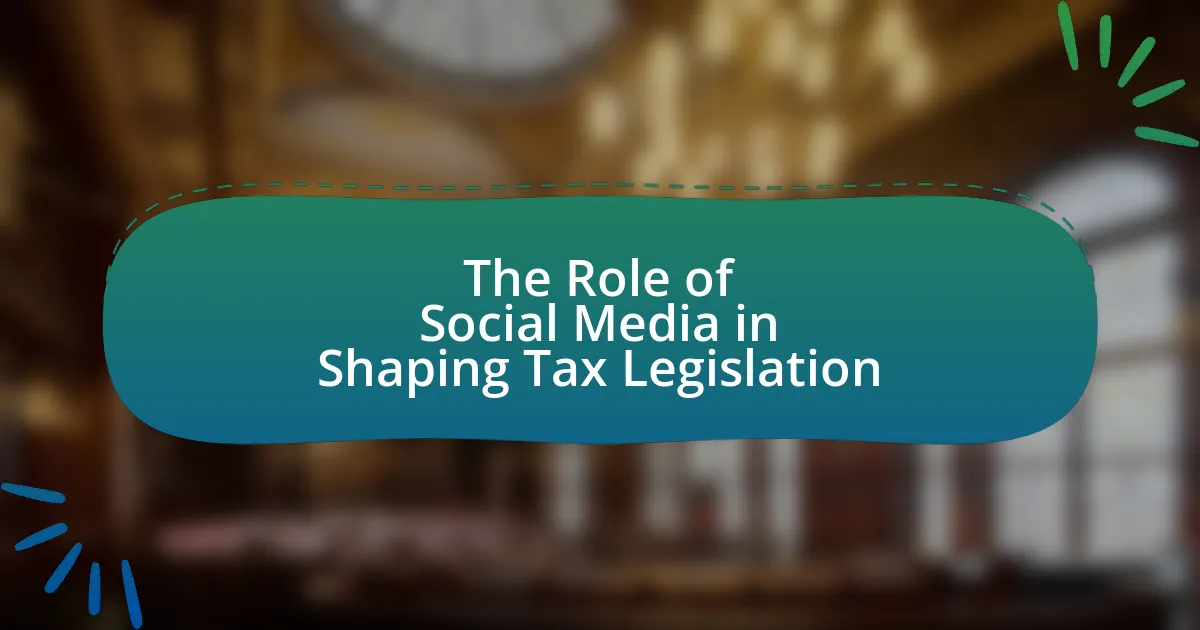The article focuses on best practices for drafting effective tax reform proposals, emphasizing key elements such as simplicity, fairness, economic growth stimulation, and revenue adequacy. It outlines how clearly defined objectives shape tax reform designs and the importance of stakeholder engagement in creating equitable policies. The article also discusses common pitfalls to avoid, the role of data and analysis in informing proposals, and methodologies for conducting impact assessments. By highlighting practical tips and resources, the article aims to guide policymakers in developing tax reforms that are clear, effective, and widely accepted.
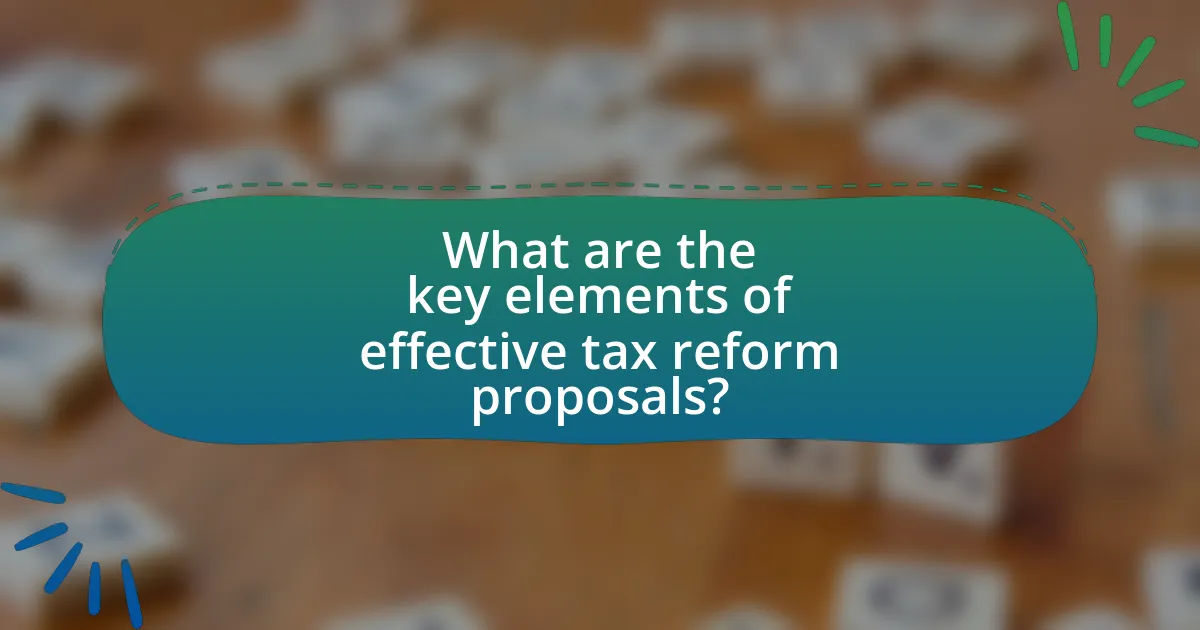
What are the key elements of effective tax reform proposals?
Key elements of effective tax reform proposals include simplicity, fairness, economic growth stimulation, and revenue adequacy. Simplicity ensures that tax codes are easy to understand and comply with, reducing administrative costs and taxpayer confusion. Fairness involves equitable treatment across different income levels and demographics, promoting social equity. Economic growth stimulation focuses on creating incentives for investment and job creation, which can enhance overall economic performance. Revenue adequacy ensures that the tax system generates sufficient funds to meet government obligations without excessive deficits. These elements are supported by historical examples, such as the Tax Reform Act of 1986 in the United States, which successfully combined these principles to broaden the tax base and lower rates, resulting in increased compliance and economic growth.
How do objectives shape tax reform proposals?
Objectives fundamentally shape tax reform proposals by guiding the design and implementation of tax policies to achieve specific economic, social, or fiscal goals. For instance, if the objective is to increase revenue, proposals may focus on broadening the tax base or increasing tax rates on higher income brackets. Conversely, if the goal is to stimulate economic growth, proposals might include tax cuts or incentives for businesses and investments. Historical examples, such as the Tax Reform Act of 1986 in the United States, illustrate how clearly defined objectives, like simplifying the tax code and promoting fairness, led to significant changes in tax policy. Thus, the alignment of objectives with tax reform proposals is crucial for their effectiveness and acceptance.
What specific goals should tax reform proposals aim to achieve?
Tax reform proposals should aim to achieve equity, efficiency, simplicity, and revenue adequacy. Equity ensures that the tax burden is distributed fairly across different income groups, which can be supported by studies showing that progressive tax systems reduce income inequality. Efficiency minimizes economic distortions and encourages growth, as evidenced by research indicating that lower tax rates on capital can stimulate investment. Simplicity reduces compliance costs and enhances taxpayer understanding, with data suggesting that simpler tax codes lead to higher compliance rates. Revenue adequacy ensures that the government can fund essential services, supported by historical data showing that well-structured tax systems can maintain stable revenue streams.
How do these objectives influence the design of tax reforms?
Objectives significantly influence the design of tax reforms by guiding the prioritization of fairness, efficiency, and revenue generation. For instance, when equity is a primary objective, tax reforms may incorporate progressive tax rates to ensure that higher-income individuals contribute a larger share, thereby addressing income inequality. Conversely, if economic efficiency is prioritized, reforms might focus on broadening the tax base and minimizing distortions in economic behavior, such as reducing tax rates on capital gains to encourage investment. Historical examples, such as the Tax Reform Act of 1986 in the United States, illustrate how a combination of these objectives led to a simplification of the tax code while increasing overall revenue. Thus, the alignment of specific objectives with the design of tax reforms is crucial for achieving desired economic and social outcomes.
What role does stakeholder engagement play in tax reform proposals?
Stakeholder engagement is crucial in tax reform proposals as it ensures that diverse perspectives are considered, leading to more equitable and effective policies. Engaging stakeholders, such as businesses, community organizations, and citizens, allows policymakers to gather insights on the potential impacts of proposed changes, identify concerns, and build consensus. For instance, research by the International Monetary Fund highlights that inclusive stakeholder processes can enhance the legitimacy and acceptance of tax reforms, ultimately resulting in better compliance and implementation outcomes.
Who are the key stakeholders in the tax reform process?
The key stakeholders in the tax reform process include government officials, policymakers, taxpayers, businesses, and advocacy groups. Government officials and policymakers are responsible for drafting and implementing tax laws, while taxpayers are directly affected by these changes. Businesses often engage in lobbying efforts to influence tax policy, and advocacy groups represent various interests, such as social equity or economic growth. Their involvement is crucial as they provide insights, feedback, and support that shape the reform process, ensuring that diverse perspectives are considered in the development of effective tax proposals.
How can stakeholder feedback improve tax reform proposals?
Stakeholder feedback can significantly enhance tax reform proposals by providing diverse perspectives that identify potential issues and opportunities for improvement. Engaging stakeholders, such as businesses, tax professionals, and community organizations, allows policymakers to gather insights on the practical implications of proposed changes, ensuring that reforms are equitable and effective. For instance, feedback from small business owners can reveal how tax changes might impact their operations, leading to adjustments that promote economic growth. Research indicates that inclusive policy-making, which incorporates stakeholder input, results in higher acceptance rates and better implementation outcomes, as seen in various successful tax reforms globally.
What are the common pitfalls to avoid in tax reform proposals?
Common pitfalls to avoid in tax reform proposals include lack of clarity, insufficient stakeholder engagement, and failure to consider economic impacts. Lack of clarity can lead to confusion and misinterpretation of the proposed changes, making it difficult for taxpayers to understand their obligations. Insufficient stakeholder engagement often results in proposals that do not address the needs or concerns of affected parties, leading to resistance and implementation challenges. Additionally, failure to consider economic impacts can result in unintended consequences, such as reduced revenue or negative effects on economic growth, as evidenced by studies showing that poorly designed tax reforms can lead to budget deficits and economic instability.
What mistakes have been made in past tax reform efforts?
Past tax reform efforts have often made mistakes such as failing to consider the long-term economic impacts, leading to unintended consequences. For instance, the Tax Reform Act of 1986, while initially successful in broadening the tax base, resulted in increased complexity and loopholes that undermined its effectiveness over time. Additionally, reforms have frequently overlooked the importance of stakeholder engagement, which can lead to public resistance and lack of compliance. The 2017 Tax Cuts and Jobs Act exemplified this, as it faced criticism for disproportionately benefiting corporations and high-income earners, which sparked debates about equity and fairness in the tax system. These mistakes highlight the necessity for comprehensive analysis and inclusive dialogue in future tax reform proposals.
How can these pitfalls be mitigated in new proposals?
To mitigate pitfalls in new tax reform proposals, stakeholders should conduct thorough stakeholder consultations and impact assessments. Engaging diverse groups, including economists, tax professionals, and affected communities, ensures that multiple perspectives are considered, reducing the likelihood of overlooking critical issues. Additionally, utilizing data-driven analysis can identify potential economic impacts and unintended consequences, as evidenced by the Tax Policy Center’s findings that comprehensive assessments lead to more effective policy outcomes. Implementing iterative feedback loops during the drafting process allows for continuous improvement and adaptation, further enhancing the proposal’s effectiveness and acceptance.
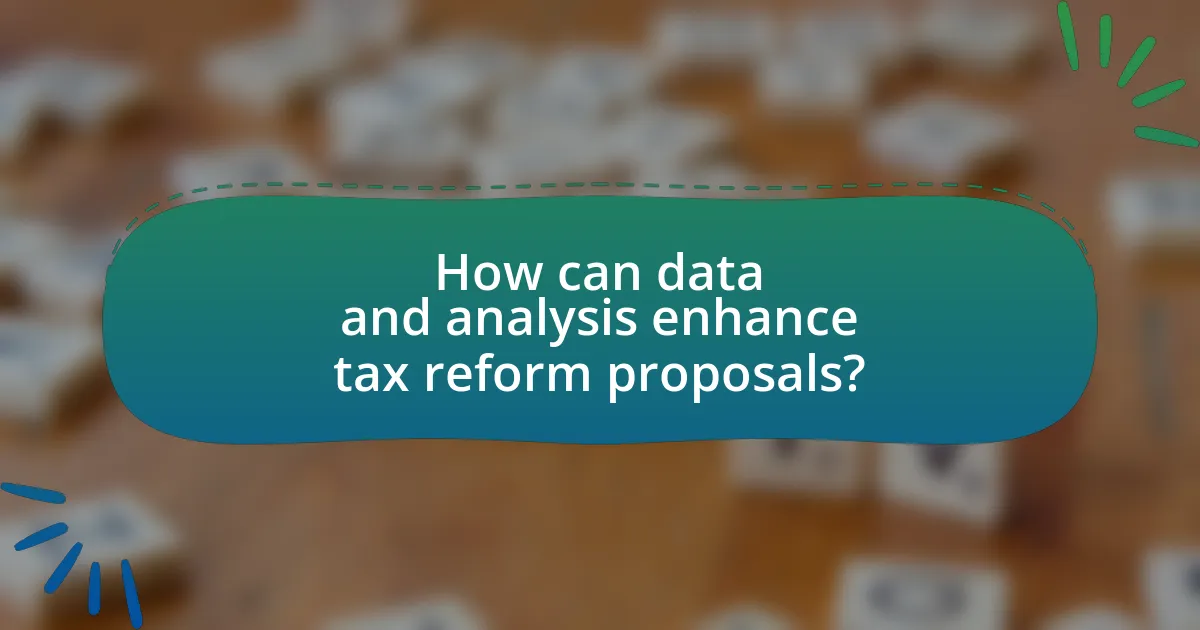
How can data and analysis enhance tax reform proposals?
Data and analysis enhance tax reform proposals by providing evidence-based insights that inform policy decisions. Utilizing comprehensive data sets allows policymakers to identify inefficiencies in the current tax system, assess the economic impact of proposed changes, and predict behavioral responses from taxpayers. For instance, the Congressional Budget Office (CBO) regularly uses economic modeling to evaluate the effects of tax reforms on revenue and economic growth, demonstrating that data-driven analysis can lead to more effective and equitable tax policies. Additionally, empirical studies, such as those published by the National Bureau of Economic Research, show that data analysis can reveal the distributional effects of tax changes, ensuring that reforms address equity concerns and target the intended beneficiaries.
What types of data are essential for drafting tax reform proposals?
Essential data for drafting tax reform proposals includes economic indicators, demographic statistics, and revenue projections. Economic indicators, such as GDP growth rates and employment figures, provide insights into the overall health of the economy, which is crucial for understanding the potential impact of tax changes. Demographic statistics, including income distribution and population trends, help identify which groups will be affected by the reforms and how. Revenue projections, based on historical tax collection data and economic forecasts, are necessary to estimate the fiscal impact of proposed changes and ensure that they align with budgetary goals. These data types collectively inform policymakers about the implications of tax reforms on different sectors and the economy as a whole.
How can economic data inform tax policy decisions?
Economic data can inform tax policy decisions by providing insights into the economic conditions, behaviors, and outcomes that influence revenue generation and taxpayer compliance. For instance, data on income distribution can help policymakers understand the impact of tax rates on different income groups, allowing for more equitable tax structures. Additionally, historical data on tax revenue and economic growth can reveal the effectiveness of previous tax policies, guiding future reforms. Research from the Congressional Budget Office indicates that tax changes can significantly affect economic activity, demonstrating the importance of using empirical data to predict the consequences of tax policy adjustments.
What role does demographic data play in shaping tax reforms?
Demographic data plays a crucial role in shaping tax reforms by providing insights into the population’s characteristics, needs, and economic behaviors. Policymakers utilize demographic information, such as age, income levels, and geographic distribution, to identify which segments of the population are most affected by existing tax policies and to design reforms that address equity and efficiency. For instance, the U.S. Census Bureau data indicates that tax reforms aimed at low-income households can significantly impact poverty rates, demonstrating the importance of tailoring tax policies to demographic realities. This data-driven approach ensures that tax reforms are responsive to the diverse needs of the population, ultimately leading to more effective and equitable tax systems.
How can impact assessments improve the effectiveness of tax reform proposals?
Impact assessments can improve the effectiveness of tax reform proposals by providing a systematic evaluation of the potential economic, social, and environmental impacts of proposed changes. These assessments enable policymakers to identify the likely consequences of tax reforms on different demographics and sectors, ensuring that the proposals are equitable and targeted. For instance, a study by the International Monetary Fund in 2021 highlighted that impact assessments can reveal how tax changes might disproportionately affect low-income households, allowing for adjustments that mitigate negative effects. By incorporating data-driven insights from impact assessments, tax reform proposals can be better aligned with desired outcomes, ultimately leading to more effective and sustainable fiscal policies.
What methodologies are used for conducting impact assessments?
Various methodologies are employed for conducting impact assessments, including cost-benefit analysis, stakeholder analysis, and environmental impact assessments. Cost-benefit analysis quantifies the economic advantages and disadvantages of a proposed action, allowing policymakers to evaluate its overall effectiveness. Stakeholder analysis identifies and assesses the interests and influences of different groups affected by the proposal, ensuring that diverse perspectives are considered. Environmental impact assessments evaluate the potential ecological consequences of a project, providing insights into sustainability and compliance with regulations. These methodologies are widely recognized in policy-making and are essential for informed decision-making in tax reform proposals.
How do impact assessments influence stakeholder perceptions?
Impact assessments significantly influence stakeholder perceptions by providing a structured evaluation of potential effects of proposed policies. These assessments offer stakeholders clear insights into the economic, social, and environmental implications of tax reforms, which can shape their opinions and decisions. For instance, a study by the World Bank found that transparent impact assessments enhance trust among stakeholders, as they demonstrate accountability and informed decision-making. Consequently, stakeholders are more likely to support tax reforms when they perceive that their interests and concerns have been adequately considered through comprehensive assessments.
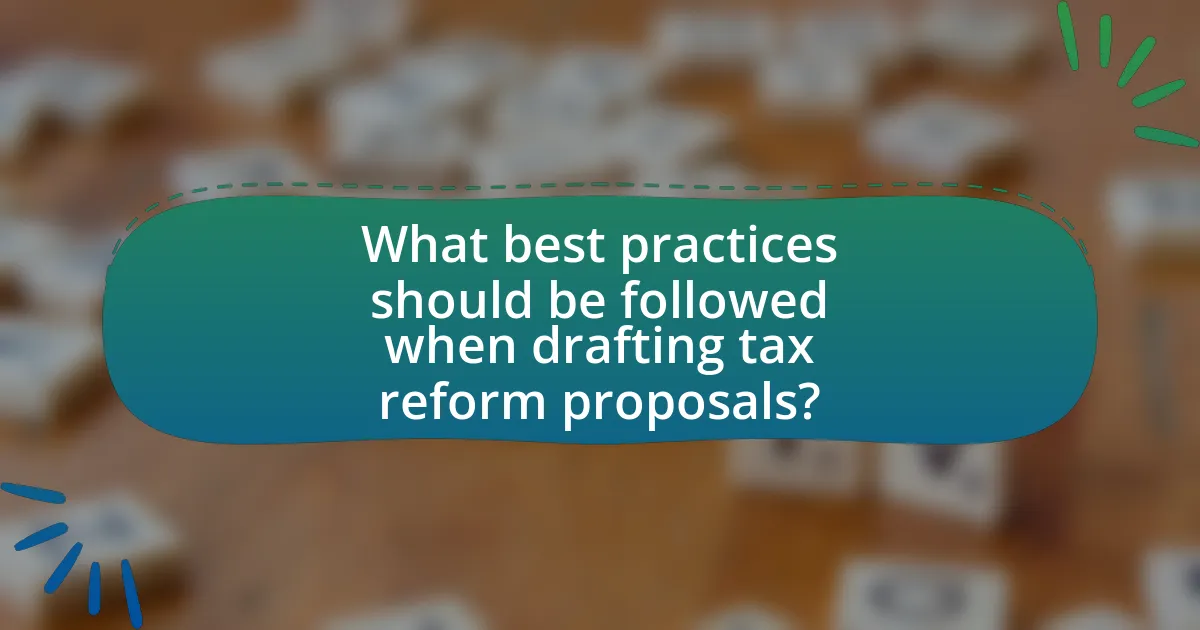
What best practices should be followed when drafting tax reform proposals?
When drafting tax reform proposals, it is essential to ensure clarity, equity, and economic efficiency. Clarity involves using straightforward language and clear definitions to avoid ambiguity, which helps stakeholders understand the proposal’s intent and implications. Equity requires that the tax system is fair, meaning that similar taxpayers should be treated similarly, and the burden should be distributed based on the ability to pay. Economic efficiency means that the tax system should minimize distortions in economic behavior, encouraging growth and investment.
Additionally, proposals should be based on comprehensive data analysis to assess potential impacts on different income groups and the overall economy. Historical examples, such as the Tax Reform Act of 1986, demonstrate that well-structured proposals can lead to significant economic growth and increased compliance when they are transparent and equitable. Engaging stakeholders throughout the drafting process also enhances the proposal’s legitimacy and acceptance, as seen in various successful tax reforms globally.
How can clarity and transparency be achieved in tax reform proposals?
Clarity and transparency in tax reform proposals can be achieved through clear communication of objectives, detailed explanations of proposed changes, and stakeholder engagement. Clear communication involves articulating the goals of the tax reform, such as increasing fairness or efficiency, in straightforward language. Detailed explanations should outline how the proposed changes will affect different taxpayer groups, supported by data and examples to illustrate potential impacts. Engaging stakeholders, including taxpayers, businesses, and advocacy groups, fosters an inclusive dialogue that can clarify concerns and enhance understanding. Research from the Tax Policy Center indicates that transparency in the legislative process increases public trust and compliance, demonstrating the effectiveness of these practices in achieving clarity and transparency.
What strategies can be employed to ensure clear communication of tax reforms?
To ensure clear communication of tax reforms, employing strategies such as simplifying language, utilizing multiple communication channels, and engaging stakeholders is essential. Simplifying language involves avoiding jargon and using straightforward terms to make the reforms accessible to a broader audience. Utilizing multiple communication channels, including social media, public forums, and official websites, ensures that information reaches diverse demographics effectively. Engaging stakeholders, such as community leaders and tax professionals, fosters dialogue and allows for feedback, enhancing understanding and acceptance of the reforms. These strategies are supported by studies indicating that clear communication significantly improves public comprehension and support for policy changes.
How does transparency build trust among stakeholders?
Transparency builds trust among stakeholders by fostering open communication and accountability. When stakeholders have access to clear and accurate information regarding decision-making processes, they are more likely to feel valued and respected. This is supported by research from the Harvard Business Review, which indicates that organizations demonstrating transparency experience higher levels of stakeholder engagement and satisfaction. Furthermore, transparency reduces uncertainty, allowing stakeholders to make informed decisions, thereby enhancing their confidence in the organization’s intentions and actions.
What are the best practices for presenting tax reform proposals?
The best practices for presenting tax reform proposals include clear communication, stakeholder engagement, and data-driven analysis. Clear communication ensures that the proposal is easily understood by various audiences, including policymakers and the public. Engaging stakeholders, such as businesses and community organizations, fosters support and addresses concerns, which is crucial for successful implementation. Data-driven analysis provides evidence of the proposal’s potential economic impact, enhancing credibility and facilitating informed decision-making. For instance, the Tax Policy Center’s analysis of tax reforms demonstrates how empirical data can clarify the effects of proposed changes on different income groups, reinforcing the importance of using solid evidence in presentations.
How can visual aids enhance the presentation of tax reform proposals?
Visual aids enhance the presentation of tax reform proposals by simplifying complex information and improving audience engagement. They allow for the effective visualization of data, such as tax rates and revenue projections, making it easier for stakeholders to understand the implications of proposed changes. Research indicates that presentations incorporating visual elements can increase retention rates by up to 65%, as visuals help to clarify and emphasize key points. Additionally, visual aids can facilitate discussions by providing a common reference point, thus fostering a more interactive and informed dialogue among policymakers and the public.
What formats are most effective for disseminating tax reform proposals?
The most effective formats for disseminating tax reform proposals include detailed reports, executive summaries, infographics, and interactive presentations. Detailed reports provide comprehensive analysis and data, allowing stakeholders to understand the nuances of the proposals. Executive summaries distill key points for quick comprehension by decision-makers. Infographics visually represent complex information, making it accessible and engaging for a broader audience. Interactive presentations facilitate real-time feedback and discussion, enhancing stakeholder engagement. These formats have been shown to improve understanding and retention of information, as evidenced by studies indicating that visual aids can increase information retention by up to 65%.
What practical tips can help in drafting effective tax reform proposals?
To draft effective tax reform proposals, focus on clarity, stakeholder engagement, and data-driven analysis. Clarity ensures that the proposal is easily understood by lawmakers and the public, which can be achieved by using straightforward language and clear structure. Engaging stakeholders, including taxpayers, businesses, and advocacy groups, allows for diverse perspectives and can enhance the proposal’s acceptance. Data-driven analysis supports the proposal with empirical evidence, demonstrating potential impacts on revenue, economic growth, and equity. For instance, the Tax Policy Center’s analysis of tax reforms shows that proposals grounded in solid data are more likely to gain bipartisan support and achieve intended outcomes.
How can collaboration among experts improve proposal quality?
Collaboration among experts can significantly improve proposal quality by integrating diverse perspectives and specialized knowledge. When experts from various fields work together, they can identify potential weaknesses in a proposal, enhance its comprehensiveness, and ensure that it addresses multiple facets of the issue at hand. For instance, a study published in the Journal of Policy Analysis and Management found that interdisciplinary collaboration leads to more innovative solutions and higher-quality outcomes in policy proposals. This is because experts can leverage their unique insights to create a more robust and effective proposal, ultimately increasing its chances of success.
What resources are available for drafting tax reform proposals?
Resources available for drafting tax reform proposals include government publications, academic research, and policy analysis organizations. Government publications, such as the Congressional Budget Office reports, provide data and analysis on tax policy impacts. Academic research from institutions like the National Bureau of Economic Research offers empirical studies on tax reform outcomes. Additionally, organizations like the Tax Policy Center and the Brookings Institution publish comprehensive analyses and recommendations for effective tax reform. These resources collectively offer valuable insights and data necessary for informed proposal drafting.
